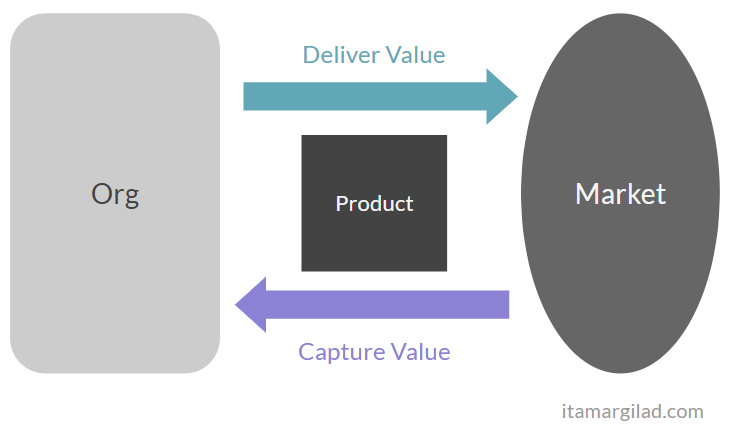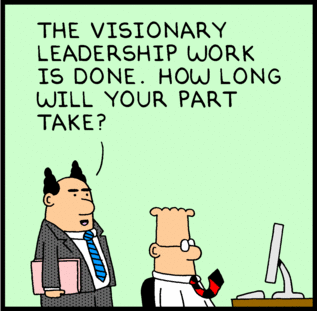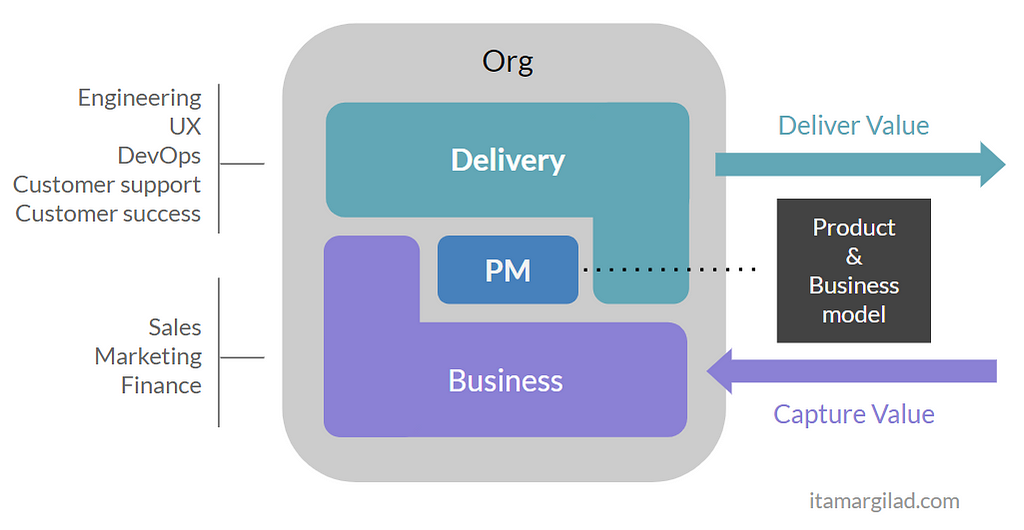Latest news about Bitcoin and all cryptocurrencies. Your daily crypto news habit.
Product management is at an interesting point. More and more companies embrace it as a way to supercharge the business, gratify customers and align the org, yet few product teams are able to deliver on these big expectations. I get asked by managers quite frequently how to get their PMs to deliver more, have more impact, be more accountable. The answer, more often than not, starts with management itself — its perception of what product management is, how it operates, and how it should be built in the org. This post describes 5 of the most important ways to address this gap.
1. Focus the PM mission on value
A good place to start is the definition of product management. Even here, there’s a lot of confusion.
This is how I like to explain it.
The mission of product management is to find and help build the right product.
What makes a product right? Two things:
- It delivers high value to a sizeable market, and
- It helps capture lots of value back. (value can be monetary or other)
Delivering and capturing value is obviously the job of the entire org. Finding the product that will best allow this is the responsibility of product managers. They don’t have to do it alone. In fact, it’s better if they pull in other people to help them. They don’t even necessarily have to have the title product manager — founders, CxOs, tech leads, and designers sometimes part-time-own product management (even if they don’t call it by this name). However, once you have product managers onboard you should hand them the difficult task of steering the product into the desirable but hard to get to high-value/high-value spot and keeping it there. That should be their full-time job.
If you prefer to receive posts like these by email sign up to my newsletter.
2. Hire product managers, not product owners
In my early days in product management there were no product owners, just product managers. The term was introduced a few years later with Scrum, the most popular Agile development methodology. Product owner (PO) is an important role within scrum, working closely with the development team as the representative of the customers/users and of other stakeholders, and, among other things, managing a prioritized product backlog that feeds the team with work items.
This sounds like a good fit for a PM, but of course it’s only a subset of what modern PMs do (more on this in the next section). In fact some believe that product managers shouldn’t even specify the solution, and instead frame the problem or opportunity and help the team discover how to best address them. This version of product management sits at odds with the more classically defined product owner.
I’m not sure that the authors of scrum intended to create a real-world role called product owner, but that’s just what happened. Today companies are hiring full-time product owners by the boatload, mainly for two reasons:
- Recent interpretations of scrum are putting far higher demands on POs, requiring them to write detailed epics and user stories, to attend planning sessions, retrospectives and daily standups, and more. This can easily become a full-time job.
- Managers like the concept of dividing the work — strategic, outbound-facing product work handled by senior, full-fledged, product managers or by the managers themselves while the grueling tactical work is handed off to the POs. It’s not the first time this was attempted, but to my knowledge it has never really worked.
If it’s not already clear, I’m not a fan of the current product-owner-as-a-full-time-job model. I don’t believe there’s a neat way to split product management work along strategic and tactical responsibilities and I don’t feel that’s a great work experience for the product owner. The solution lies in reducing the tactical load on POs, through delegation to team members and reduction in process overhead, enabling them to perform the other important functions of the PM.
3. Encourage PMs to be intrapreneurs
Google, Facebook, Amazon and other leading tech companies expect and encourage their PMs to act as intrapreneurs. They believe this is key to staying innovative and nimble. In this vein I coach product managers to employ both the mindset and the toolset of the entrepreneur even when working in larger companies. These include:
- Optimizing for learning AND execution
- Creating agile plans that assume constant change
- Setting and tracking metrics
- Idea prioritization using impact, effort and evidence
- Running experiments and build-measure-learn loops
- Business-model focus
I think it’s worth spending a few sentences on this last point because it’s major.
According to Steve Blank, one of the originators of Lean Startup, the objective of a startup is not to build the best product, nor to drive the most short term sales, it’s to find a scalable and repeatable business model. I think there’s a lot established orgs can learn from this. The business model helps tie the two main parts of the org — the business teams (sales, marketing, business-dev etc.) and the delivery teams (engineering, design, QA, devops, etc.) into one organic entity — a sort of yin-yang of value delivery and capture.
Modern-day PMs therefore no longer attempt to bridge between the teams or act as gatekeepers. They seek to break the walls entirely and get everyone to work together, with a focus on the business model as a whole. This manifests in cross-functional-work, shared objectives, and user/business-focused metrics, among other things.
4. Look for the right skills, not for the right resume
When hiring PMs there’s a usual laundry list of things everyone is looking for, however some qualities that are just important, tend to be overlooked:
- Analytical thinking — Good PMs are good at breaking problems into their parts, doing pro and con assessments, coming up with guesstimates, analyzing facts and data, and estimating probabilities and distributions. Interview question — “How much storage does Evernote require to support its UK users?”
- User/Customer empathy — The ability to understand and share the feelings of another person who may be very different from you is key to building a product that delivers value for that person. I found that some people are just more naturally inclined to see things through the eyes of their target audience and are able to articulate this view back to others. It’s not a common skill — most of us just assume that other people are like us. Interview question — “Design an AirBnB-like app for people who are vision-impaired”.
- Humility — Product managers have a lot of power over the product. An over-confident PM who fully trusts his/her intuition and judgment and does not need proof is every bit as bad as a manager who has these traits. Strong opinions, held lightly is what we’re after. Interview question — “Tell me of a time when you got into a strong disagreement with someone over the requirements you set. How did you handle the situation?”
… and others get too much attention:
- Education — OK, I admit that I think that an engineering degree (or significant hands-on experience) is very helpful for PMs, but then again I’ve seen good PMs come from all walks of life. Background in psychology or design is a plus. Same for business degree. An MBA is definitely not a must.
- Domain expertise — I’m seeing companies spend quarters looking for a PM that has just the right experience in their industry and in their business model. Don’t worry about it — good PMs are generalists and can learn quickly. Don’t let go of someone talented just because of lack the domain knowledge.
- Work experience — it’s not hard to build an impressive-looking CV. Resumes are a way to filter candidates, but once the candidate is in the interview process, they should not play a factor in hiring. It’s the results of the interviews, ideally based on multiple interviewers, that should matter.
5. Set the right reporting chain
Product managers are a special breed of animal — neither engineering nor business nor design. They thrive when they report to senior PMs who understand their unique set of challenges, can coach them, and give them the freedom they need to do their jobs. Reporting to non-PMs, while possible and not uncommon, can hamper career growth and performance.
My general recommendation to CEOs is to create a product org reporting to a chief product officer (CPO). If there’s no CPO its best to have the PM org report to a multidisciplinary manager that has responsibility over both product and business, typically the CEO or head of a business unit.
It’s not a good idea to have product managers report to a pure-engineering manager or a pure-marketing/sales manager. As well-meaning as those individuals may be, in both cases goals will not be well aligned. Instead of focusing on finding the right product the PMs may be asked to help close deals (aka business PMs) or help make engineers fully productive and happy (technical PM, or now, product owner). I’ve been there and I can tell you it’s not fun for the PM and not helpful for the org.
Final thoughts
Product management has evolved a lot in the last 15–20 years. The methodologies and tools I teach PMs today are very different from the ones I practiced in the early 2000s. How you build a product management team has changed as well. Finding the right people, placing them in a dedicated PM-orgs, and letting them act as value-focused intrapreneurs instead of as (solely) product owners, will take you a very long way.
Itamar Gilad (itamargilad.com) is a product consultant and speaker helping companies build high-value products. Over the past 15 years he held senior product management roles at Google, Microsoft and a number of startups.
If you prefer to receive posts like these by email sign up to my newsletter.
5 Tips for Building Effective Product Management Teams was originally published in Hacker Noon on Medium, where people are continuing the conversation by highlighting and responding to this story.
Disclaimer
The views and opinions expressed in this article are solely those of the authors and do not reflect the views of Bitcoin Insider. Every investment and trading move involves risk - this is especially true for cryptocurrencies given their volatility. We strongly advise our readers to conduct their own research when making a decision.


